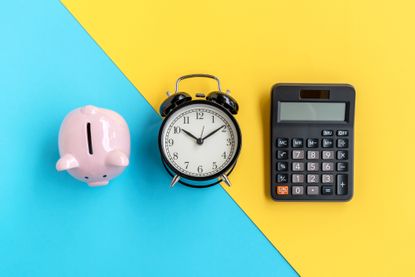Savings Calculator: Check How Much Your Money Will Grow
Our savings calculator can show you just how much your money will grow over time.


Curious how much your savings could grow over time? A savings calculator can help. Whether you’ve just opened one of the best CD accounts or opted for a high-yield savings account with an impressive APY, this calculator can easily show you just how much cash you’ll have after a specified period of time, taking into account compound interest and any regular monthly contributions.
At its latest meeting, the Federal Reserve held interest rates steady for the seventh consecutive time. Since the Federal Reserve began holding interest rates steady, savings rates have slowly fallen. However, higher-than-expected inflation has postponed any rate cuts for the time being, meaning rates will remain higher for longer than anticipated. Earlier this year, the Federal Reserve projected three interest rate cuts in 2024 to reduce the federal funds rate to a range of 4.5% to 4.75%. Now officials are estimating just one quarter-point cut for the year.
Savings calculator
To use the calculator, start by inputting the amount of cash you're starting with, or the initial deposit. From there, add in the amount you plan on contributing to the account as a monthly deposit. After this, you'll then be able to choose from a number of savings accounts with varying APYs. Select a period of time over which your investment will grow, and our calculator will do the work for you, calculating your potential savings.

Sign up for Kiplinger’s Free E-Newsletters
Profit and prosper with the best of expert advice on investing, taxes, retirement, personal finance and more - straight to your e-mail.
Profit and prosper with the best of expert advice - straight to your e-mail.
How much should you save?
How much you should save each month really depends on your specific financial situation, but a general rule of thumb is to put aside three to six months’ salary or living expenses in an emergency fund. Another general rule that can help you prioritize savings is the 50-30-20 budget rule, in which you’ll budget 50% of your monthly income toward necessities, 30% toward wants and 20% towards savings.
Choosing a savings account
Choosing a savings account depends on your personal financial goals. Here's what to consider.
Certificate of Deposit (CD): A certificate of deposit, or CD, is a type of savings account that holds a fixed amount of money for a fixed period of time. Typical term lengths for CDs range anywhere from three months to five years, so it’s not somewhere you’d store cash you need easy access to. Instead, it’s a good place to save cash you’re holding onto for a particular savings goal. For example, you may plan on purchasing a vehicle or making a down payment on a home in two years and are looking for a no-risk way to grow these savings.
Savings account: On the other hand, savings accounts are better suited for cash you’ll want easy access to, like emergency fund savings. If you’re looking to maximize these savings, consider opening a high-yield account. High-yield savings accounts are the same as traditional savings accounts, but they pay a higher-than-average APY on deposits.
Balance and deposit requirements: Some accounts have minimum balance and/or deposit requirements. If you fail to meet these, you could incur a fee.
Safety: Be sure to check whether a savings account is FDIC or NCUA insured to keep your savings safe.
Compare some of the best savings accounts below.
Related Content
Get Kiplinger Today newsletter — free
Profit and prosper with the best of Kiplinger's advice on investing, taxes, retirement, personal finance and much more. Delivered daily. Enter your email in the box and click Sign Me Up.

Erin pairs personal experience with research and is passionate about sharing personal finance advice with others. Previously, she was a freelancer focusing on the credit card side of finance, but has branched out since then to cover other aspects of personal finance. Erin is well-versed in traditional media with reporting, interviewing and research, as well as using graphic design and video and audio storytelling to share with her readers.
-
 The Secret Credit Card for Amazon Prime Day Shopping
The Secret Credit Card for Amazon Prime Day ShoppingThis "secret" credit card for Amazon Prime Day shopping can maximize your cash back rewards. Plus get a $300 bonus.
By Erin Bendig Published
-
 This Trust Can Protect Your Assets From Long-Term Care Costs
This Trust Can Protect Your Assets From Long-Term Care CostsA Medicaid asset protection trust can help ensure your protected assets go to your beneficiaries rather than your long-term care, but it has to be set up properly.
By Joe F. Schmitz Jr., CFP®, ChFC® Published
-
 How Much Umbrella Insurance Do I Need?
How Much Umbrella Insurance Do I Need?umbrella insurance Having too much liability insurance is better than having too little. Use our calculator to determine how much umbrella insurance is right for you.
By Erin Bendig Last updated
-
 Snag a $900 Bonus for Opening a Checking Account
Snag a $900 Bonus for Opening a Checking AccountBasics Want to get a bonus for opening a checking account? Just make sure you read the fine print.
By Ellen Kennedy Last updated
-
 Household Budget Worksheet
Household Budget Worksheetfamily savings Use this budget worksheet to get control of your monthly living expenses.
By Staff Published